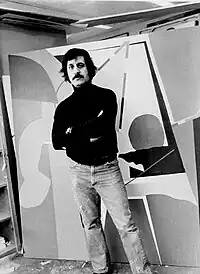Sari Ibrahim Khoury
Sari Ibrahim Khoury (March 13, 1941 – June 18, 1997, Arabic: سري خوري) was a Palestinian-American visual artist originally from Jerusalem. He primarily worked in abstract modes in acrylic, oil and charcoal.
Sari Ibrahim Khoury | |
|---|---|
 Photo of the artist in 1975 | |
| Born | 1941 |
| Died | 1997 Detroit, Michigan |
| Nationality | Palestinian/American |
| Education | Cranbrook Academy of Art |
| Known for | Painting, Drawing |
| Movement | Abstract Expressionism |
Early life
Sari Ibrahim Khoury was born in Jerusalem, Mandate Palestine in 1941. Years after becoming a refugee in 1948 and his family's eviction from Jerusalem, he emigrated to the United States to attend school. In a personal statement from 1996, he described the impact the loss of Palestine had on him:
My family lived in the new sector of Jerusalem, Palestine until 1948 when we were all forced to leave our homes under a hail of bullets and explosions during the war. We left everything behind including all our family albums. I was seven years at the time, and the ensuing years were extremely difficult for a family that had been accustomed to a comfortable cultured way of life.[1]
Drawing was a form of therapy and coping for him at an early age.
The dispossession of a homeland took its toll on our entire family. As an impressionable child I witnessed all kinds of upheavals and painful situations and learned to internalize the agony of our impoverished status. My therapy from all this was in drawing. I drew figures, and tormented faces, old wrinkled people. From an early age, I rejected bourgeois values, pretty objects of art, and political deception. Even then, I knew that to pursue art would be a lonely voyage.[1]
Emigration to the United States
After spending the remainder of his time in Palestine in Bir Zeit, Khoury came to the United States at age 17 on a fine arts scholarship to Ohio Wesleyan University. There, he earned a Bachelor of Arts and completed his Master of Fine Arts at Cranbrook Academy of Art in Detroit. He married his wife, Suheila Ghannam, in 1967. Together, they had three sons.
Career and exhibitions
Khoury began his academic career as professor of fine art at Berea College, KY and subsequently at Central Michigan University in Mt. Pleasant, MI. He taught painting and drawing for 31 years.
Khoury began teaching at Central Michigan University in the Art Department in 1967. He served as chairperson of the department from 1992 to 1993. On July 21, 2001, the Board of Trustees of Central Michigan University recognized posthumously that Khoury be promoted to professor emeritus rank.[2]
His works have been exhibited in the United States, Europe, Japan, and in Palestine. His exhibition roster includes fifteen solo exhibits, some posthumous, and over forty group exhibits.[3] A major commissioned mural sits at the Arab Community Center for Economic and Social Services in Dearborn, MI highlighting the accomplishments and contributions of Arab Americans. In 2008, the Arab American National Museum opened a major retrospective of his work.[4] Shortly after, Birzeit University Virtual Gallery also created an online retrospective. In 2019, the newly opened Museum of the Palestinian People in Washington DC houses a painting and drawing in its collection.
Illness and death
Khoury was diagnosed with an aggressive form of brain cancer in 1996. Khoury died in June 1997.
Public involvement
Khoury was an active participant in Arab-American life in Michigan. He frequently spoke and wrote articulately against war and on Palestinian justice. Many of his writings, photos and other archival material are held at the Bentley Historical Library at the University of Michigan. They form part of a historical collection on Arab, Muslim, and Assyrian Americans in Michigan.[5] In 1987, Khoury was commissioned by the Arab Community Center for Economic and Social Services (ACCESS) to paint a mural depicting Arab-American life, social, professional and cultural contributions to Michigan. It is housed and displayed in the renovated ACCESS[6] office in Dearborn, MI.
Style
The Palestinian artist and historian, Samia Halaby referred to the moment when she first discovered Khoury's works, through personal correspondence:
I was excited to see the flavors of Arabic calligraphy in his work co-existing with the radical formal qualities of twentieth century abstraction.[7]
Khoury describes the free-style line both as an independent object and edge of a shape as an important characteristic of his work in the 1990s.
The activity of drawing is important to me even as I paint. So there is always the presence of the line either used independently or as it describes the edge of a shape. I have learned that it could be spontaneous or restrained or awkward or jagged or fluent thus expressing my emotional state of mind much as a jazz musician chooses to fluctuate with the mood of the moment. Color meant more to me earlier, but recently I have given it less importance in avoidance of what can become decorative.[1]
Khoury references the works of modern artists Paul Klee, Ben Nicholson, Arshile Gorky, and Wassily Kandinsky as sources of inspiration.[1]
References
- "The artwork of Sari Khoury".
- "Archived copy" (PDF). Archived from the original (PDF) on 2011-06-15. Retrieved 2011-01-04.
{{cite web}}: CS1 maint: archived copy as title (link) - "The artwork of Sari Khoury: Exhibitions".
- "Arab American National Museum". www.arabamericanmuseum.org. Archived from the original on 2007-12-23.
- "Arab Americans, Chaldeans, and Muslims in Michigan". Archived from the original on 2010-08-19. Retrieved 2011-01-04.
- "Arab American National Museum Curatorial Department Blog". Archived from the original on 2010-12-13. Retrieved 2011-01-15.
- "Palestinian Artist Sari Khoury".
- Boullata, Kamal (2009). Palestinian Art 1850-2005. London: Saqi. ISBN 978-0-86356-648-6.
- Oweis, Fayeq (2008). Encyclopedia of Arab American Artists. Westport: Greenwood Press. ISBN 978-0-313-33730-7.
- Arida, Holly (2007). Etching Our Own Image: Voices from Within the Arab American Art Movement. Cambridge Scholars Publishing. ISBN 978-1-84718-195-4.